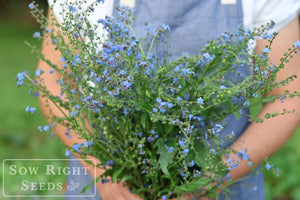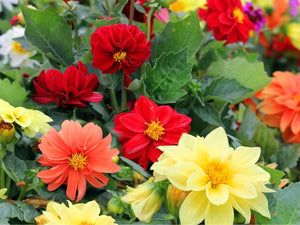Organic Gardening Made Easy: 7 Steps to Grow Naturally
Types of gardens
What Does the Word “Organic” Mean?
People use the term “organic” to mean a lot of different things when it comes to gardening and vegetables. It can be a confusing term. Let’s start off with three common uses of organic.
Organic matter - Decaying plant and animal waste. Organic matter is an important component of all healthy soil.
Organic gardening - A way of gardening that promotes more natural types of gardening. Organic gardening is generally a more natural, holistic approach to gardening, rather than depending on synthetic chemicals as fertilizers, herbicides, and pesticides.
Organic agricultural products - This is a much more specialized term. In the United States, the USDA certification requires sellers to meet strict standards in order to sell their products with the USDA organic label. These farmers use a lot of the same methods as organic gardeners but on much larger scales.

Why Grow Organic?
Many people are very interested in organic gardening for a variety of reasons.
Health - Many synthetic products used in conventional farming are derived from things like petroleum and can be toxic to use in large quantities. If you want to avoid ingesting harmful chemicals, not using them in your own garden is a great start.
Organic produce also wins against conventionally grown produce in terms of vitamin and mineral content. It’s tastier, too!
Environmental Impact - Synthetic chemical products are not only unhealthy for humans but also for the environment.
Synthetic herbicides and insecticides can damage healthy pollinator populations and soil productivity, especially when used on large scales. Run-off from fertilizers can poison waterways and harm local ecosystems.
Soil Health - Healthy soil is part of the greater ecosystem, but it’s also a matter of practicality. Healthier soil is more productive and easier to maintain without needing as much aeration or replacement due to erosion.
Cost - Organic gardening methods are often much less expensive than their chemical counterparts. Making your own compost, conserving your soil health, and using recycled materials can save you a lot of money in the long run.

7 Steps to Organic Gardening
If you’re trying to get organic certification, you need to be incredibly strict with your methods. But for the aspiring organic home gardener, here are some general steps to get you to your goals.
Build Healthy Soil
Build on your success from the ground up. Getting your soil tested is a great first start. Millions of organisms live in healthy soil and contribute to its microbiome.
Use Natural Fertilizers
If your soil needs some extra TLC, fish fertilizer, compost, and worm castings are all great sources of food for your garden.
Rotate plant families
By changing what you grow from year to year, you’ll build nutrients in your soil rather than depleting it. This is also an easy way to discourage pests and diseases.
Grow more diverse gardens
Monocultures encourage pests and deplete soils. Companion planting can help your garden thrive and give you even more enjoyment.
Use Cover Crops
In the off-season, don’t allow your beds and gardens to become overrun with weeds or to become compacted. Cover crops help improve the soil in between crops by gathering nutrients and outcompeting weeds. When the time comes to plant your next crop, the remaining residue can be used as mulch.
Weed Control
Mulch, gardening fabric, and good old-fashioned hand pulling are three simple, non-toxic ways to keep weeds at bay. In our Sow Right Seeds gardens, we use a layer of mulch in most of our beds. We also have our favorite weeding tools to tackle the weeds.
Pest control
This is possibly the trickiest part of gardening, organic or not. Did you know that almost all organic pesticides are used by conventional gardeners, too? Regularly check your plants for pests and use barriers like row covers and cutworm collars.
Each of these steps will lead to a more natural approach to gardening.
Once you’ve laid the groundwork for organic gardening there may be times where you need extra help with pest control. That's where understanding more about pesticides becomes essential.

Understanding the Half-Life of Pesticides
When you choose a product to manage pests, it’s important to understand how long it lingers in your garden environment.
The half-life is the amount of time it takes for half of a pesticide’s active ingredient to break down or lose its effectiveness. For example, if a pesticide has a half-life of 10 days, half of the original amount remains after 10 days, and only a quarter remains after another 10 days.
Why It Matters in an Organic Garden
Organic gardeners strive to create a living ecosystem where soil organisms, pollinators, and beneficial insects thrive. The persistence of a pesticide can make a big difference:
Short half-life = better for the ecosystem.
Natural or organic-approved products like neem oil or Bt break down quickly in sunlight and soil, leaving minimal residues behind.Long half-life = higher environmental impact.
Synthetic or copper-based products may remain active for weeks or even months, potentially affecting soil microbes, beneficial insects, and future crops.Residue safety.
Pesticides with short half-lives are less likely to leave residue on edible plants, which is essential for gardeners who harvest often.
Typical Half-Life Examples
Product |
Approximate Half-Life |
Notes |
Neem oil |
1–4 days |
Breaks down quickly in sunlight |
Pyrethrin |
<1 day |
Fast-degrading; good for organic use |
Glyphosate |
3–130 days |
Persists longer depending on soil type |
Copper fungicide |
Does not degrade |
Can build up in soil; use only when necessary |

The Organic Gardener’s Takeaway
Here are some guidelines that can help you when you need to use chemicals:
Don’t spray what you’ll eat. Lettuce leaves should be left alone. They are eaten raw, and there’s no barrier to what is sprayed on them.
Pumpkin leaves are okay to spray because you eat the inside of the pumpkin.
Spraying consistently builds resilience in the pests. It is better to use pesticides as a last resort.
Spraying kills both the bad and good bugs. You need pollinators and beneficial insects in your garden.
Be logical. At times, it can make sense to use a middle-of-the-road approach.
Whenever possible, choose products that break down quickly, apply them sparingly, and rely on preventive practices like crop rotation, companion planting, and healthy soil building to keep pests in check naturally.
Following these steps for organic gardening will give you a healthier garden overall. It can take an investment of time, but you'll appreciate the benefits for years to come.
Popular Posts
-

How to Grow Chinese Forget-Me-Nots from Seed to Blue Bouquet
-

From Seed to Spectacular Blooms: How to Grow Dahlias from Seed









Leave a comment